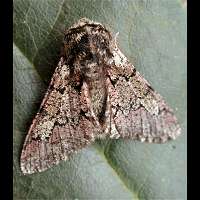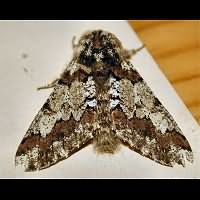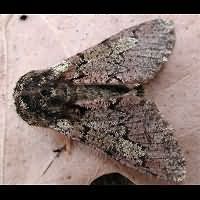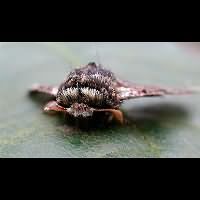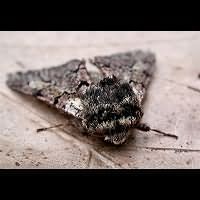Oak Beauty (Biston strataria)
The Oak Beauty is a robust, hairy Geometer, appearing in early spring and looking like an Owlet Moth very much. Males and females are very different. Males have large, broad wings with banded markings. They may be identified as Geometers, even though they are very variable both in colour and markings. Many animals have wings suffused with dark brown, others are even entirely melanistic. Females have long, slim and very pointed wings and look like anything but a Geometer. Their wings are often dark coloured and only slightly marked, if at all. In the top picture the animal to the left is a male, the one to the right a female. The same female is in the bottom picture. She is full of eggs, hence the fat body. In all other pictures are male animals. Identifying is made easy by the size of the animals (wingspan 51 to 58 mm) and the flying period in early spring.
The eggs of the Oak Beauty hatch in May and the caterpillar feeds till the end of July. It is your typical Geometer Worm. The colour is highly variable: reddish brown, reddish grey or greenish grey. On the back it has two darkbrown bumps. Three more of those are found on the underside of the larva. The head is reddish brown. When it stretches out, it is very similar to a twig. It feeds during the night and sits stretched out during the day between the twigs. The caterpillar isn't very fat, but quite long, for it may reach a length of 56 mm. By the end of July or the beginning of August the caterpillar moves underground to pupate. It is the pupa which overwinters. It will feed on many trees and shrubs, even though it apparently favors oak, alder, beech and birch. In gardens it is sometimes found on roses.
The Oak Beauty is a spring time species, usually flying in March and April. In mild winters regularly on the wing in February. Flies by night only. Males are easily attracted to lights, females are not and actually are rarely seen. Common in woodlands, parklands and sometimes bigger gardens. A widespread, but rather local species in England and Wales. Uncommon in Scotland and Ireland. In other parts of Europe a widespread but often local species. Not to be found in Northern Europe (including Northern Scandinavia and Northern Scotland)
The Oak Beauty is a robust, hairy Geometer, appearing in early spring and looking like an Owlet Moth very much. Males and females are very different. Males have large, broad wings with banded markings. They may be identified as Geometers, even though they are very variable both in colour and markings. Many animals have wings suffused with dark brown, others are even entirely melanistic. Females have long, slim and very pointed wings and look like anything but a Geometer. Their wings are often dark coloured and only slightly marked, if at all. In the top picture the animal to the left is a male, the one to the right a female. The same female is in the bottom picture. She is full of eggs, hence the fat body. In all other pictures are male animals. Identifying is made easy by the size of the animals (wingspan 51 to 58 mm) and the flying period in early spring.
The eggs of the Oak Beauty hatch in May and the caterpillar feeds till the end of July. It is your typical Geometer Worm. The colour is highly variable: reddish brown, reddish grey or greenish grey. On the back it has two darkbrown bumps. Three more of those are found on the underside of the larva. The head is reddish brown. When it stretches out, it is very similar to a twig. It feeds during the night and sits stretched out during the day between the twigs. The caterpillar isn't very fat, but quite long, for it may reach a length of 56 mm. By the end of July or the beginning of August the caterpillar moves underground to pupate. It is the pupa which overwinters. It will feed on many trees and shrubs, even though it apparently favors oak, alder, beech and birch. In gardens it is sometimes found on roses.
The Oak Beauty is a spring time species, usually flying in March and April. In mild winters regularly on the wing in February. Flies by night only. Males are easily attracted to lights, females are not and actually are rarely seen. Common in woodlands, parklands and sometimes bigger gardens. A widespread, but rather local species in England and Wales. Uncommon in Scotland and Ireland. In other parts of Europe a widespread but often local species. Not to be found in Northern Europe (including Northern Scandinavia and Northern Scotland)


